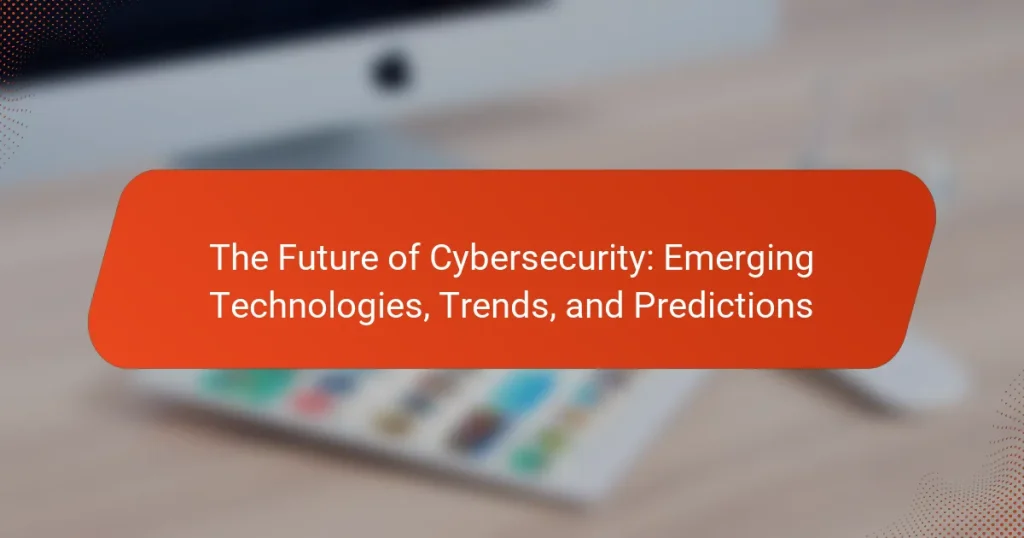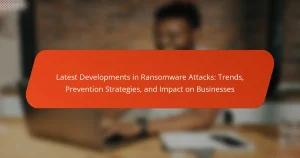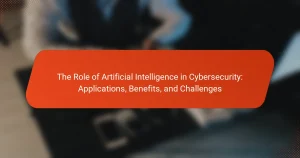The article focuses on the future of cybersecurity, highlighting the impact of emerging technologies and evolving trends. Key technologies such as artificial intelligence (AI), machine learning, blockchain, and quantum computing are shaping threat detection, response capabilities, and encryption methods. The article discusses the importance of zero-trust architectures, the need for an expanded cybersecurity workforce, and the increasing emphasis on regulatory compliance. Current trends include the adoption of cloud security solutions and the necessity for employee training to mitigate human error, reflecting the dynamic nature of cybersecurity in response to sophisticated threats.
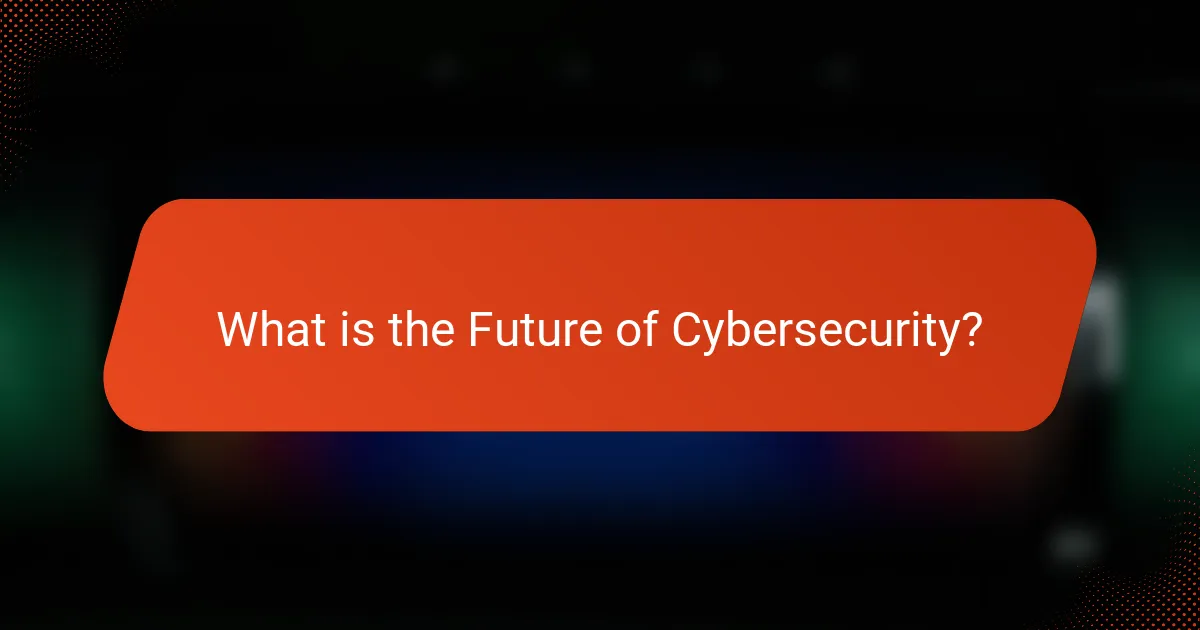
What is the Future of Cybersecurity?
The future of cybersecurity will increasingly rely on advanced technologies and proactive strategies. Artificial intelligence (AI) will play a crucial role in threat detection and response. Machine learning algorithms will analyze vast amounts of data to identify anomalies. Zero-trust architectures will become standard, ensuring that no user or device is trusted by default. The rise of quantum computing presents both challenges and opportunities for encryption methods. Cybersecurity regulations will evolve to address new threats and compliance requirements. The global cybersecurity workforce will need to expand to meet growing demands. According to Cybersecurity Ventures, cybercrime damages are projected to reach $10.5 trillion annually by 2025, highlighting the urgency for robust security measures.
How is cybersecurity evolving in the digital age?
Cybersecurity is evolving rapidly in the digital age due to increasing threats and technological advancements. The rise of cloud computing has expanded the attack surface for cybercriminals. Organizations are adopting artificial intelligence to enhance threat detection and response. Machine learning algorithms analyze vast data sets to identify anomalies in real time. Furthermore, the Internet of Things (IoT) introduces new vulnerabilities that require innovative security measures. Regulatory frameworks are becoming stricter, pushing companies to prioritize cybersecurity. The shift towards zero trust architecture is gaining traction, emphasizing continuous verification of users and devices. These trends illustrate how cybersecurity is adapting to meet the challenges of a digital landscape.
What are the key factors driving change in cybersecurity?
The key factors driving change in cybersecurity include the rise of sophisticated cyber threats, regulatory compliance, and the adoption of emerging technologies. Sophisticated cyber threats, such as ransomware and advanced persistent threats, are increasing in frequency and complexity. According to Cybersecurity Ventures, global cybercrime damages are expected to reach $10.5 trillion annually by 2025. Regulatory compliance mandates, like GDPR and CCPA, compel organizations to enhance their security measures. The rapid adoption of technologies such as cloud computing, IoT, and AI also introduces new vulnerabilities. These technologies require innovative security solutions to protect sensitive data. Additionally, the growing awareness of cybersecurity risks among businesses and consumers is driving investment in security infrastructure. This investment is critical for maintaining trust and safeguarding digital assets.
How do emerging threats shape the future of cybersecurity?
Emerging threats significantly shape the future of cybersecurity by necessitating advanced protective measures. Cybercriminals continuously evolve their tactics, exploiting new technologies and vulnerabilities. For instance, the rise of artificial intelligence (AI) has introduced sophisticated attack vectors. In 2022, cyberattacks utilizing AI increased by over 30%. This trend compels organizations to adopt AI-driven security solutions to counteract these threats. Moreover, the proliferation of Internet of Things (IoT) devices expands the attack surface. By 2025, it is estimated that there will be over 75 billion connected devices. This growth requires enhanced security protocols to protect against IoT-specific vulnerabilities. Additionally, the increase in ransomware attacks has led to a focus on incident response and recovery strategies. In 2021, ransomware attacks surged by 150%. Consequently, organizations are investing in resilience and recovery capabilities. Overall, the dynamic landscape of emerging threats drives innovation and adaptation within the cybersecurity field.
Why is it important to understand trends in cybersecurity?
Understanding trends in cybersecurity is crucial for protecting sensitive information. Cyber threats evolve rapidly, making it essential to stay informed. Organizations can anticipate potential vulnerabilities by tracking these trends. This proactive approach allows for timely updates to security measures. According to Cybersecurity Ventures, global cybercrime damages are projected to reach $10.5 trillion annually by 2025. Awareness of trends aids in resource allocation for effective defense strategies. Additionally, understanding trends fosters compliance with regulations and standards. This knowledge ultimately strengthens an organization’s resilience against cyber attacks.
What impact do trends have on cybersecurity strategies?
Trends significantly influence cybersecurity strategies by shaping priorities and resource allocation. For example, the rise of remote work has led organizations to enhance their network security measures. Increased cyber threats, such as ransomware attacks, have prompted a focus on incident response planning. Additionally, the adoption of cloud services has necessitated stronger data protection protocols. Trends in regulatory compliance also drive organizations to update their security frameworks. The emergence of artificial intelligence in cybersecurity is reshaping threat detection and response capabilities. Overall, staying attuned to trends allows organizations to proactively adapt their strategies to mitigate risks effectively.
How can organizations prepare for upcoming trends?
Organizations can prepare for upcoming trends by conducting regular market research. This research identifies emerging technologies and shifts in consumer behavior. Additionally, organizations should invest in training their workforce on new tools and methodologies. This ensures employees are equipped to handle future challenges. Collaborating with industry experts can provide insights into best practices. Implementing agile strategies allows organizations to adapt quickly to changes. Moreover, monitoring competitors helps organizations stay ahead of industry trends. A proactive approach to cybersecurity, including regular assessments, enhances resilience against threats. According to a 2021 report by Cybersecurity Ventures, global cybersecurity spending is expected to exceed $1 trillion from 2021 to 2025, highlighting the importance of preparedness.
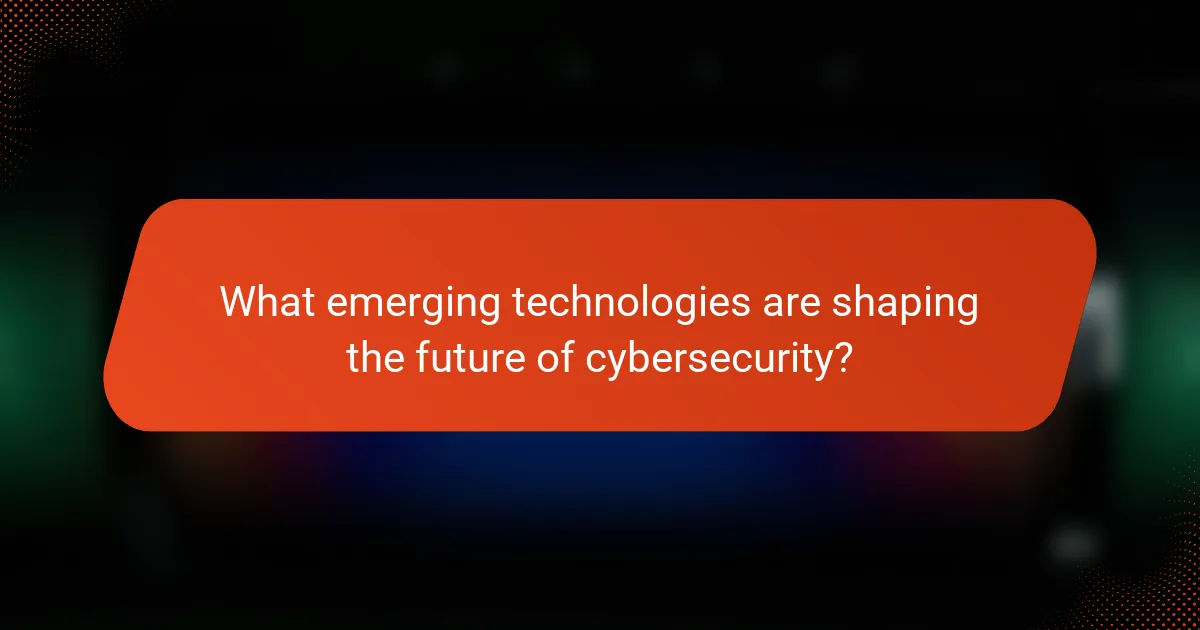
What emerging technologies are shaping the future of cybersecurity?
Artificial intelligence and machine learning are emerging technologies shaping the future of cybersecurity. These technologies enhance threat detection and response capabilities. AI algorithms analyze vast amounts of data to identify patterns indicative of cyber threats. Machine learning models adapt to new threats over time, improving their accuracy. Blockchain technology also plays a role in cybersecurity. It offers secure and transparent transaction records, reducing fraud risks. Quantum computing is another emerging technology impacting cybersecurity. It has the potential to break traditional encryption methods, necessitating new security protocols. Additionally, automation in cybersecurity streamlines processes and reduces human error. These technologies collectively strengthen defenses against evolving cyber threats.
How is artificial intelligence influencing cybersecurity?
Artificial intelligence is significantly influencing cybersecurity by enhancing threat detection and response capabilities. AI algorithms analyze vast amounts of data to identify patterns indicative of cyber threats. This capability allows for real-time monitoring of networks and systems. Machine learning models can adapt and improve over time, increasing their effectiveness against evolving threats. According to a report by Cybersecurity Ventures, AI-driven cybersecurity solutions can reduce incident response times by up to 90%. Additionally, AI helps automate routine security tasks, allowing cybersecurity professionals to focus on more complex issues. The integration of AI in cybersecurity is becoming essential as cyber threats grow in sophistication and volume.
What are the benefits of AI in threat detection?
AI enhances threat detection by improving accuracy, speed, and efficiency. It analyzes vast amounts of data in real-time. This capability allows for the identification of threats that might go unnoticed by human analysts. AI algorithms can learn from past incidents to predict future threats. According to a report by McKinsey, AI can reduce false positives by up to 90%. This leads to more focused and effective responses to genuine threats. Additionally, AI can automate routine monitoring tasks, freeing up human resources for complex analysis. These benefits collectively strengthen an organization’s cybersecurity posture.
How can AI improve incident response times?
AI can significantly improve incident response times by automating threat detection and analysis. It processes vast amounts of data quickly, identifying anomalies that may indicate security incidents. AI algorithms can prioritize alerts based on severity, reducing the noise from false positives. This allows security teams to focus on critical threats promptly. Furthermore, AI-driven tools can execute predefined responses automatically, mitigating incidents before human intervention is needed. According to a report by IBM, organizations using AI for security can reduce the time to identify and contain breaches by up to 27%. This efficiency translates to faster recovery and less potential damage from cyber threats.
What role does blockchain technology play in cybersecurity?
Blockchain technology enhances cybersecurity by providing decentralized data storage and immutable records. This decentralization reduces the risk of single points of failure. Each transaction on a blockchain is encrypted and linked to the previous one, making tampering nearly impossible. Furthermore, blockchain enables secure identity management through cryptographic keys. This ensures that only authorized users can access sensitive information. Studies indicate that implementing blockchain can decrease data breaches by up to 80%. Additionally, its transparency allows for real-time auditing and monitoring of data integrity.
How does blockchain enhance data integrity and security?
Blockchain enhances data integrity and security through its decentralized and immutable nature. Each transaction is recorded in a block and linked to previous blocks. This chain of blocks forms a secure ledger that is difficult to alter. Once a block is added to the chain, it cannot be changed without altering all subsequent blocks. This feature ensures data integrity by preventing unauthorized modifications. Additionally, blockchain employs cryptographic techniques to secure data. Each transaction is encrypted, making it accessible only to authorized users. The decentralized network of nodes validates transactions, further enhancing security. This structure reduces the risk of single points of failure and attacks. Studies show that blockchain can reduce fraud and increase trust in digital transactions.
What are the limitations of using blockchain for cybersecurity?
Blockchain has limitations for cybersecurity. One major limitation is scalability. As transaction volume increases, the performance can degrade significantly. Another limitation is energy consumption. Many blockchain networks require substantial energy for mining and transaction verification. Additionally, blockchain does not prevent all types of cyberattacks. For example, 51% attacks can compromise network integrity. Furthermore, smart contracts may contain vulnerabilities. These vulnerabilities can lead to exploits if not properly coded. Finally, regulatory and compliance challenges exist. These challenges can hinder the adoption of blockchain in cybersecurity frameworks.
How are quantum computing advancements impacting cybersecurity?
Quantum computing advancements are significantly impacting cybersecurity by introducing new capabilities and challenges. Quantum computers can process vast amounts of data at unprecedented speeds. This ability poses a threat to traditional encryption methods. For instance, quantum algorithms like Shor’s algorithm can efficiently factor large numbers, undermining RSA encryption.
As a result, sensitive information could be more easily compromised. The National Institute of Standards and Technology (NIST) is working on post-quantum cryptography standards to address these vulnerabilities. These new standards aim to develop encryption methods resistant to quantum attacks. The transition to quantum-resistant algorithms is crucial for securing future digital communications.
In summary, while quantum computing offers powerful tools for data processing, it also necessitates a fundamental shift in cybersecurity practices to protect against new threats.
What are the potential risks posed by quantum computing?
Quantum computing poses significant risks to cybersecurity. It has the potential to break current encryption methods. Classical encryption relies on mathematical problems that quantum computers can solve efficiently. For example, Shor’s algorithm allows quantum computers to factor large numbers quickly. This capability threatens the security of widely used encryption protocols like RSA. Additionally, quantum computing could enable advanced attacks on cryptographic systems. The development of quantum computers is progressing rapidly. As of 2023, organizations are urged to prepare for these risks. Transitioning to quantum-resistant algorithms is essential for future security.
How can cybersecurity measures adapt to quantum threats?
Cybersecurity measures can adapt to quantum threats by implementing quantum-resistant algorithms. These algorithms utilize mathematical problems that are difficult for quantum computers to solve. For instance, lattice-based cryptography is considered a strong candidate for post-quantum security. Current encryption methods, like RSA and ECC, are vulnerable to quantum attacks. Quantum computers can potentially break these encryption methods using Shor’s algorithm. Organizations should transition to quantum-safe protocols to safeguard sensitive data. Research from the National Institute of Standards and Technology (NIST) supports the development of these new standards. By adopting these measures, cybersecurity can remain robust against evolving quantum threats.
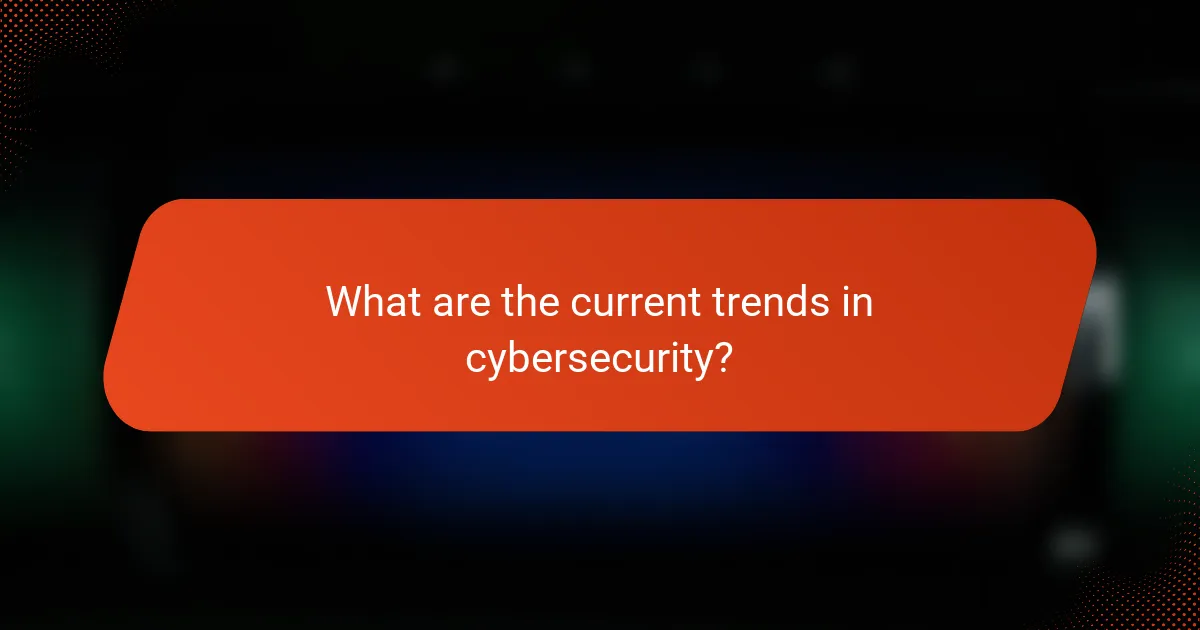
What are the current trends in cybersecurity?
Current trends in cybersecurity include the rise of artificial intelligence for threat detection. Organizations are increasingly adopting AI to analyze data patterns and identify anomalies. This technology enhances the speed and accuracy of threat response. Another trend is the growing emphasis on zero-trust security models. Zero-trust requires verification for every user and device trying to access resources. It mitigates risks associated with insider threats and compromised credentials. Additionally, there is a surge in the use of cloud security solutions. Businesses are migrating to cloud environments, necessitating robust security measures. Cybersecurity training for employees is also gaining importance. Human error remains a leading cause of breaches, making training essential. Finally, regulatory compliance is becoming more stringent. Organizations are adapting to new laws like GDPR and CCPA to avoid penalties. These trends reflect the evolving landscape of cybersecurity as threats become more sophisticated.
How is the rise of remote work affecting cybersecurity practices?
The rise of remote work is significantly affecting cybersecurity practices. Organizations are increasingly adopting cloud-based solutions to support remote access. This shift expands the attack surface for cyber threats. Employees often use personal devices, which may lack adequate security measures. As a result, the risk of data breaches and phishing attacks has escalated. According to a report by Cybersecurity Insiders, 70% of organizations experienced increased cyber threats during the shift to remote work. Additionally, companies are investing in advanced security measures, such as multi-factor authentication and VPNs, to mitigate these risks. Overall, remote work is reshaping the cybersecurity landscape, necessitating more robust security protocols and employee training.
What new vulnerabilities have emerged with remote work?
New vulnerabilities have emerged with remote work, primarily related to cybersecurity risks. Increased reliance on personal devices has led to a rise in unsecured networks. Employees often use home Wi-Fi, which may lack proper security measures. Phishing attacks have also surged, targeting remote workers who may be more vulnerable. Additionally, collaboration tools can expose sensitive information if not properly configured. The absence of physical security measures in home environments increases risks of data breaches. According to a report by IBM, remote work has contributed to a 20% increase in cyber incidents. These factors collectively create a challenging landscape for cybersecurity in remote work settings.
How can organizations secure remote work environments?
Organizations can secure remote work environments by implementing strong cybersecurity measures. This includes using virtual private networks (VPNs) to encrypt internet connections. Multi-factor authentication (MFA) adds an extra layer of security for accessing systems. Regular software updates and patches help protect against vulnerabilities. Employee training on phishing and social engineering threats is essential. Utilizing endpoint protection software safeguards devices against malware. Data encryption ensures sensitive information remains secure during transmission. Regular security audits help identify and mitigate risks. According to a report by Cybersecurity Ventures, cybercrime damages are expected to reach $10.5 trillion annually by 2025, highlighting the importance of robust security measures.
What trends are emerging in regulatory compliance for cybersecurity?
Emerging trends in regulatory compliance for cybersecurity include increased focus on data privacy and protection. Governments are implementing stricter regulations, such as the General Data Protection Regulation (GDPR) in Europe. Organizations are now required to adopt comprehensive data protection measures. Compliance frameworks are evolving to address new threats, particularly in cloud computing and remote work environments. Additionally, there is a growing emphasis on incident response and reporting obligations. This shift aims to enhance transparency and accountability in cybersecurity practices. Regular audits and assessments are becoming standard to ensure compliance with evolving regulations. The integration of artificial intelligence in compliance monitoring is also gaining traction. These trends reflect the dynamic nature of cybersecurity regulations in response to emerging threats.
How do regulations influence cybersecurity strategies?
Regulations significantly influence cybersecurity strategies by establishing mandatory compliance standards. These regulations compel organizations to adopt specific security measures to protect sensitive data. For example, the General Data Protection Regulation (GDPR) requires businesses to implement strong data protection protocols. Non-compliance can result in hefty fines, which incentivizes adherence to these regulations. Additionally, regulations often dictate the reporting of data breaches within a specific timeframe. This requirement encourages organizations to enhance their incident response strategies. Furthermore, industry-specific regulations, such as HIPAA for healthcare, necessitate tailored cybersecurity approaches. Overall, regulations shape the cybersecurity landscape by driving organizations to prioritize security and invest in protective technologies.
What are the key compliance frameworks organizations should follow?
Organizations should follow key compliance frameworks such as GDPR, HIPAA, PCI DSS, and ISO 27001. GDPR protects personal data and privacy for individuals in the EU. HIPAA sets standards for the protection of health information in the United States. PCI DSS establishes security measures for organizations handling credit card transactions. ISO 27001 provides a framework for establishing, implementing, and maintaining an information security management system. These frameworks help organizations manage risk and ensure compliance with legal and regulatory requirements.
What predictions can be made about the future of cybersecurity?
The future of cybersecurity will see an increase in AI-driven security solutions. These solutions will enhance threat detection and response times. Predictions indicate that machine learning will identify patterns in cyber threats more effectively. Additionally, the rise of quantum computing will challenge current encryption methods. Organizations must adapt their security frameworks to counter these advancements. Cybersecurity regulations will likely become more stringent globally. This will push companies to prioritize compliance and data protection. Furthermore, remote work will continue to expand the attack surface for cyber threats. As a result, businesses will invest more in securing remote access technologies.
How might the landscape of cyber threats change in the next decade?
The landscape of cyber threats is expected to evolve significantly in the next decade. Increased reliance on interconnected devices will lead to more vulnerabilities. The rise of artificial intelligence will enable more sophisticated cyber attacks. Attackers may utilize AI to automate and enhance their strategies. Additionally, the proliferation of quantum computing could break existing encryption methods. This would necessitate new cybersecurity measures to protect sensitive data. The growing trend of remote work will also expand the attack surface for cybercriminals. Cybersecurity professionals will need to adapt to these changes to mitigate risks effectively.
What proactive measures can organizations take to stay ahead?
Organizations can implement several proactive measures to stay ahead in cybersecurity. They should conduct regular risk assessments to identify vulnerabilities. This allows them to prioritize their security efforts effectively. Investing in advanced threat detection technologies is crucial. These technologies can identify potential threats before they cause damage. Continuous employee training on cybersecurity best practices is also essential. Educated employees are less likely to fall victim to phishing attacks. Additionally, organizations should establish incident response plans. These plans ensure a quick and efficient reaction to security breaches. Collaborating with cybersecurity experts can provide valuable insights into emerging threats. Finally, adopting a zero-trust security model can enhance overall protection. This model assumes that threats can exist both inside and outside the network.
What best practices should organizations follow to enhance cybersecurity?
Organizations should implement multi-factor authentication to enhance cybersecurity. This practice adds an extra layer of security beyond just passwords. Regularly updating software and systems is also crucial. Outdated software can be a significant vulnerability. Conducting employee training on cybersecurity awareness is essential. Human error is often a leading cause of security breaches. Organizations should perform regular security audits and assessments. This helps identify and rectify potential weaknesses. Establishing an incident response plan is vital. It ensures a quick and organized response to any security incidents. Using firewalls and intrusion detection systems can help monitor network traffic. These tools detect and respond to suspicious activities. Finally, data encryption is critical for protecting sensitive information. It ensures that even if data is intercepted, it remains unreadable.
How can regular training improve employee awareness and response?
Regular training improves employee awareness and response by enhancing knowledge and skills related to cybersecurity. It equips employees with the latest information on threats and vulnerabilities. Training sessions can cover topics like phishing attacks and data protection protocols. Employees learn to identify suspicious activities and respond appropriately. According to a report by the Ponemon Institute, organizations that conduct regular training reduce the risk of data breaches by 45%. This statistic underscores the importance of continuous education in fostering a proactive security culture. Regular training also builds confidence in employees, enabling them to act decisively during security incidents. Overall, consistent training creates a more informed workforce that can better protect organizational assets.
What tools and technologies are essential for robust cybersecurity?
Essential tools and technologies for robust cybersecurity include firewalls, intrusion detection systems (IDS), antivirus software, and encryption protocols. Firewalls act as barriers to block unauthorized access. Intrusion detection systems monitor network traffic for suspicious activity. Antivirus software protects against malware and viruses. Encryption protocols secure data by converting it into a coded format. Additionally, security information and event management (SIEM) systems analyze security alerts in real-time. Multi-factor authentication (MFA) adds an extra layer of security by requiring multiple forms of verification. Regular software updates and patch management are crucial to address vulnerabilities. Together, these tools create a comprehensive cybersecurity strategy.
The main entity of the article is cybersecurity, focusing on its future shaped by emerging technologies, trends, and predictions. The article outlines the increasing reliance on artificial intelligence and machine learning for threat detection, the adoption of zero-trust architectures, and the implications of quantum computing on encryption methods. It discusses the evolving regulatory landscape, the impact of remote work on cybersecurity practices, and the importance of proactive measures for organizations to enhance their security posture. Key trends such as the rise of sophisticated cyber threats and the necessity for a skilled workforce are also highlighted, emphasizing the urgency for robust cybersecurity strategies in a rapidly changing digital environment.
